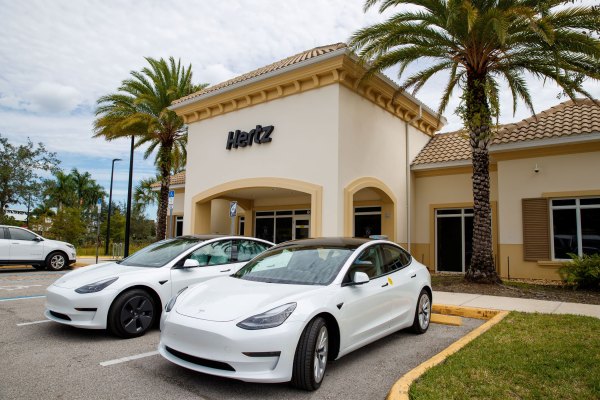Auto rental giant Hertz gave its strongest signal to the markets that it had resurrected from bankruptcy with this week’s news that it would purchase 100,000 Tesla vehicles for a reported $4.2 billion. Hertz made headlines again two days later, when it said that Uber committed to renting up to half of that order for its drivers.
But the biggest winner in the deal may end up being Tesla — which can leverage its first-to-rental market advantage and inventory constraints facing other automakers to potentially capture a growing pool of EV-curious drivers.
The first thing that jumps out is the scale of the deal — until now unheard of for EVs, Ivan Drury, an auto industry analyst with Edmunds.com, explained. “[Rental car companies] are not buying a lot EVs,” he said. “We’re not talking about bulk order traditional fleet sales.” (Hertz, Enterprise Holdings and Avis Budget Group declined to disclose what portion of their fleets are electric.)
“For Hertz to go forward and buy 100,000 [Teslas], but on top of that, 50,000 are reserved for Uber drivers — that throws in a completely different dynamic from what we’ve ever seen from the rental agencies,” he added.
The sale — which was apparently for sticker price, CEO Elon Musk confirmed — is also a clear indicator that Tesla is prepared to fulfill a major order of Model 3s by the end of next year. Traditional automakers, meanwhile, may be hung up on a backlog of EV reservations for new customers, Michelle Krebs, an analyst at Cox Automotive, said. “Automakers have been focusing on retail sales to consumers, not selling to rental car fleets during the pandemic and subsequent chip and vehicle inventory shortage,” she said.
“Try before you buy” at scale
The upside isn’t just monetary. According to a 2015 survey from Enterprise Holdings, the parent company of Enterprise Rent-A-Car, National Car Rental and Alamo Rent A Car, around 62% of respondents said a positive rental experience with a specific model made them consider purchasing one themselves.
EVs have been unable to benefit from this potential consumer interest in the traditional rental car market. Until this point, startups have largely been filling in the gap for those looking to rent an EV for their getaway. Nextmove and Future.rent in Germany specialize in EV-only rentals, while here in the U.S. peer-to-peer car rental marketplace Turo offers a mix of electric and internal combustion engine models.
The demand is there, at least according to peer-to-peer rental marketplace Turo. The number of Teslas listed for rent on Turo has exploded over the past five years, the company said. In 2014, there were 67 Teslas listed on Turo’s marketplace; so far in 2021, that number has jumped to 21,599. For EVs overall, for the same time period, the number increased from 196 to 26,956.
Many people who list cars on Turo report that their Teslas are being rented not necessarily for trips, but for longer test drives. “For a lot of people, the hour that you have sitting in a Tesla [for a test drive] isn’t enough,” a Turo spokesperson said. “Some potential buyers have range anxiety and want to try a Tesla out for long-distance trips. A lot of our hosts are telling us that guests have been trying Teslas on Turo because in a way you can really call it your own for an extended period of time.”
The market for Tesla rentals at Hertz will not just be traveling Tesla owners, but also consumers who have wanted to test drive a Tesla and possibly “EV curious” consumers, Krebs said.
“It is a great marketing situation for Tesla, which doesn’t buy advertising,” she added. “Instead, Hertz is doing the advertising using 7-time Super Bowl Champion Tom Brady — and Tesla rides the coattails.” Of course, while Tesla does not use traditional advertising to sell its vehicles, it’s worth noting that Musk has 54 million followers on Twitter and has shown his is adept at keeping his (and his company’s name) in the press.
Drury also noted that automakers often aim to use rental car agencies as marketing arms to push their most-loaded vehicles. “So for Tesla, this becomes a test drive center.”
The risk of anti-rental bias
Of course, there’s no free lunch. The main risk to Tesla, Drury said, is if the Model 3 falls prey to the perception that rental vehicles, and possibly vehicles used for Uber rides, have less value than non-rental cars. “Is the rental stigma going to stick to them? Or this [deal] is going to shed that off?”
Hertz has said that it will offer a “premium and differentiated rental experience” for the Tesla EVs, and that rental prices will be comparable to Hertz’ existing luxury segment, which suggests that the company could maintain its premium associations. Teslas booked through Uber will not be limited to Uber Black, its premium service; they will also be available to those booking through UberX.
There could also eventually be a risk to Tesla in the secondhand market, should the volume of Teslas in rental fleets increase. According to a 2017 report from Edmunds, used cars that came from rental fleets sold for 9% less in the secondhand market compared to those that did not. This matters for Tesla because these 100,000 Model 3s sold to Hertz will eventually end up in auction (or at Carvana, through a new deal with Hertz), and the automaker could risk saturating the used car market and devaluing their brand, or that specific model. This single order will likely not be enough units to make that happen, but it nevertheless introduces a new dynamic between the Tesla Model 3 and the used car market that wasn’t there prior.
Regardless of how popular perception pans out, we’re likely to see similar deals for fleet-level orders for more EVs in the future, especially as major automakers ramp up production volumes in non-sedan segments, like trucks and SUVs.
